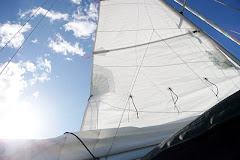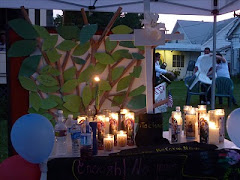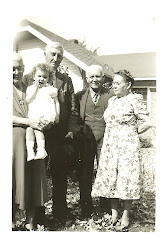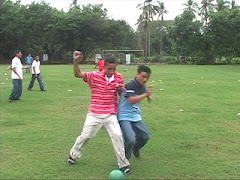GATHERING UNDER CANDLES
--for K, T, V, K
After-walking with first coffee before sunrise and psalms, lighting two candles. This altar collection below, an after-fall, a gleaning. Three painted match boxes, three polished stones, four tiny crosses from El Salvador. All gifts, themselves gathered as if sentient. Candles, too, had arrived wrapped and unmerited. Fall of life, full of color, each touched with hand-held back-story light-shade and bees wax.
The match boxes hand-painted by a friend. Each one paint-raised, lifted, solid circles, three circles on each, three color-rich song tones and bright. Lift one and it rattles. This one, a painted orange box, its one green circle the outer ring, center ring yellow and hot-to-the-touch red in the center. Red target-red, fire circle red, and dying-fire-red as if sunset dusted. Unsigned match boxes, come from the fire of a friend coming through fire, recalling my sister’s offhand telling of her bare-feet fire-walk this spring over hot coals when there was no fire in the forest. These red targets of redemption. This match-box painting friend, a woman, a poet, and serious student of archetypes and Jungian psychology. It is under-stood between them that she is sending another telling of the little girl and the match-box. The matches inside are meant to burn more than kindling. They come from one who knows how to build a hot fire, a fire that will not burn out. I am not told how to build a fire myself, not directly, but implications are clear: Build a hotter fire. It strikes me,--
here, the candles have been forgotten entirely. The candles, too, had come from a friend,
a man, a poet, who came to town to read some baseball poems. And there had been pie. He had taken two candle sticks from shelves behind the pantry closet and put them on the coffee table. How hot do candles burn? Excuse the digression. It was not my intention to enter into the wonders of archetypes
or death psychology (is it supposed to be depth psychology), but several weeks ago, some El Salvadoran crosses I had given to a pastor friend were found in cleaning out her desk drawers were returned to me, and without thinking, I placed them around the candle sticks. Each morning I’ve been struck as if striking a match by the mirror images of the crosses to the match boxes. Nearly exact in size. The smaller crosses fit into a match box. I share this to give you a sense of proportion. The match box is not a coffin. If you have never seen an El Salvadoran cross, or, for that matter, worn one, you’re missing out. El Salvadoran crosses are crosses of life. But to go back.
El Salvadoran crosses are hand-painted by children in primary colors. Their bright colors tell the story of el pueblo. Mi gente. I have placed one cross, the bright green, on my notebook where I’m writing this, in order to look at it more closely. The crosses, made of wood, are painted in enamel. Bright, deep, rich. (My earlier infatuation with fossil-fueled sports cars from England would call the color of this two-inch cross, British Racing Green.) Enough of this spotted-fragmented and lost past, my story is rural, poor, not material. I sit before these candles as one who has talked his way around faith. This tiny cross on my notebook comes with seven, yes seven, painted images.
From the top right, a portion, or piece of the sun, bright red morning with yellow rays, part for the whole. Child-inspired. Painters and poets employ this technique in their daily lives. (This cross was most likely painted by an older child.) (Yes, there’s a word for it.) Descending the vertical upright post, its tree, is a large, tropical flower, red, orange, yellow and green, out-sized here, and brilliantly full, filling the entire width of the painted wood. Beautiful, where the body of Jesus would traditionally be seen, or, be, in other cross traditions. Beneath the flower, a white dove in flight. And below the dove, a yellow chalice, its base unseen, off the cross but inside the cup, what appears to be a large white orb. This image is made more important by seven tiny black and radiating brush strokes surrounding the orb, perhaps ‘egg’ is a more accurate word. I wonder if my friend who gave me the painted match boxes, knows about El Salvadoran crosses. Or has one? If she doesn’t, I could give her one of these surrounding the candle sticks around the quilted panel on the altar, which is also a coffee table. The hand-made table-runner sewn by wife, in ten story-telling squares. Table-running and fire. Walking across fire-coals.
I suspect you know about the coffee table. Its patience also understood. But wait, I’m not finished. This one cross has more to offer.
On the right crossbar (horizontal) crossing the intersection, a small, swimming fish, red scales, blue fins and blue tail. A white head and one white eye. On the other side of the bar, and also on the other side of the tropical flower, is the largest cluster of purple grapes--they wouldn’t fit into your largest cereal bowl from your kitchen, complete with green leaves and wooden vines. Each grape in the cluster must be less than one-sixteenth of an inch. Cluster-this-packed. Grapes this ripe. Grape cluster larger than the dove, than the fish. This cross, this bright green cross (and speaking of things happening in intersections, last night, another friend, immigrant, undocumented, sends an image on my Iphone of an umbrella, paragua,in Spanish: a deluge of rain, with this: Los libros, Las mentes, y los paraguas Solo sirven Si se abren—books, ideas, umbrellas, they only work if they’re open. She’s Mexicana. Her husband, deported, is from El Salvador.
This cross, this bright green cross on my notebook, and all the crosses, all the match books, original, this green one fits in my hand, is not a crucifixion or a crucifix, but a cross of life. Say it again. This is not my imagination ballooning on you. These village images make up the essence of the El Salvadoran cross. Nor does this cross negate what the crossbars on any cross points to—that being those two other crosses on each side of Jesus, to his left and to his right, the two criminals, Barrabas, and the other one for whom we have no name, the first congregation theologians tell us. How far we’ve come.
El Salvadorans call their crosses trees of liberation, trees of life. They are, well, they’re beautiful, objects of beauty, which is to say, crosses that arrive with stories. They are crosses that come with suffering, and they cross through sorrow to joy. These, certainly, like the matchboxes, like the candle sticks, like the candles wrapped in tissue by my friend, the ones resting on the table runner. Everything rests here, but the crosses are meant to be worn around the neck. They come with an eyelet wound into its top or apex, so that a string can go through. They are crosses of experience, of suffering and trouble
and resurrection, crosses of pilgrims, gardens, children walking to school. They mirror match boxes in size and detail. They are fun-filled and full of fun. And lit each morning by candles, candles running down, light descending. Color-filled and resting beside polished stones, which I enjoy along with the psalms each morning in this softest of light, the warmest of fires.
Jim Bodeen
21 May 2022—16 October 2022










































































No comments:
Post a Comment